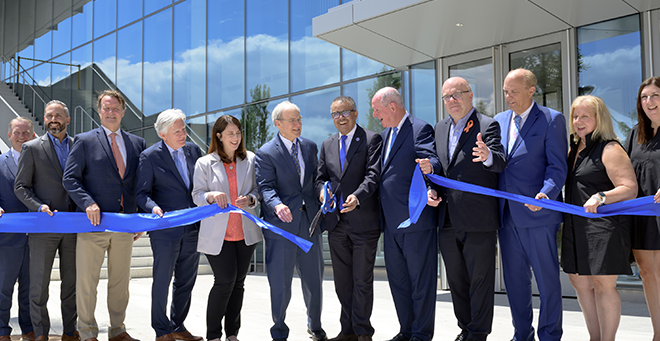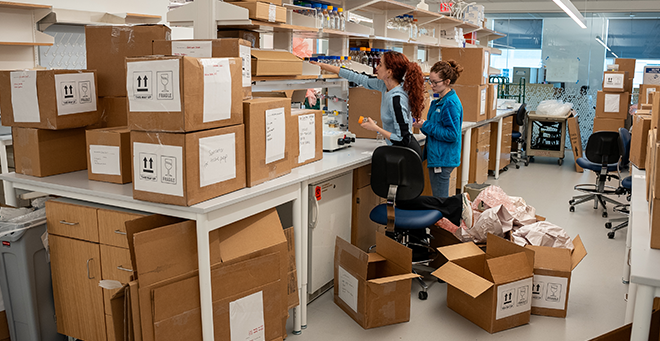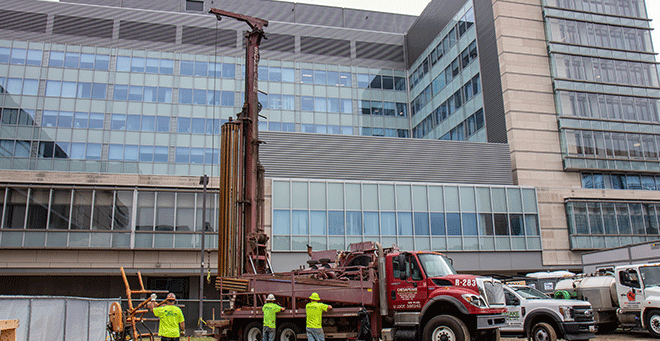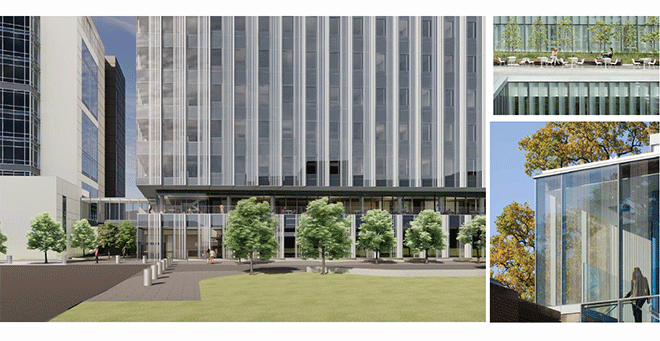
Elected officials and school leaders share the ceremonial ribbon cutting for the new education and research building on Friday, June 7 with Director-General of the World Health Organization, honorary Doctor of Science degree recipient and keynote speaker Tedros Adhanom Ghebreyesus, PhD (center, with scissors).
Proclaiming that the next generation of medical advances could arise from research conducted in its labs, offering hope to people around the world, leaders from near and far celebrated the ceremonial ribbon cutting for UMass Chan Medical School’s new education and research building on June 7.
The 350,000-square-foot building will be home to more than 70 principal investigators, focused on gene therapy, the neurosciences and molecular medicine. The building, which also provides space for UMass Chan to train more future physicians, nurse leaders and scientists, is designed to achieve LEED Gold certification for energy efficiency and sustainability.
“Today’s ceremonial ribbon cutting heralds the start of a new, dynamic chapter in UMass Chan’s unfolding narrative; one where we will witness a convergence of hope and expectation; aspiration and realization; intent and impact,” said Chancellor Michael F. Collins. “The opening of the NERB represents a substantial down payment in furtherance of our institutional commitment to change the course of the history of disease—in Worcester, for the world.”
World Health Organization Director-General Tedros Adhanom Ghebreyesus, PhD, was presented with an honorary Doctor of Science degree by Chancellor Collins and gave the keynote address. Dr. Tedros, as he is known, is globally recognized as a health scholar, advocate and diplomat with first-hand experience in research, operations and leadership in emergency responses.
Tedros is the first WHO director-general from the WHO African region. After taking office as leader of WHO in 2017, he has focused the organization on supporting countries in three key areas: promoting health and preventing disease; progressing toward universal health coverage; and preparing for, preventing and responding effectively to health emergencies.
“Although the building is new, its twin purposes—education and research—are not,” Tedros said. “They have always been central to the mission of this school, just as they have always been central to improvements in health globally, and to our work at the World Health Organization."
Tedros spoke to UMass Chan’s emphasis on primary care as the essential foundation of any health system.
“WHO estimates that about 90 percent of essential health services can be delivered at the primary health care level,” he said.
Adding that “primary care does not deliver itself,” Tedros addressed WHO’s priorities to bridge a shortage of 10 million health care workers to achieve health-related targets in its Sustainable Development Goals by 2030. He welcomed the opportunity to discuss with Collins potential partnership with the WHO Academy in Lyon, France, which is expected to open in December. The WHO Academy is intended to become a global center for lifelong learning in health and for building capacity in the health and care workforce globally.
Tedros also lauded UMass Chan’s impressive track record in research, including the Nobel Prize-winning research on RNA interference that “has opened the door to new treatments against many diseases.”
“The key challenge we face is to ensure that the fruits of research are available to all people; that they serve to narrow inequalities, rather than widen them,” said Tedros.
Tedros highlighted amendments to the International Health Regulations and a plan to extend negotiations for another year on a new Pandemic Agreement, based on lessons learned from the COVID-19 pandemic, that were recently agreed to at the World Health Assembly in Geneva.
“This new education and research building will change the face of UMass Chan Medical School, and future classes of scientists, nurses and physicians will continue to benefit from the forward-thinking vision of Chancellor Collins and his team,” said UMass President Marty Meehan. “We look forward to seeing the inspiring UMass Chan community grow into this new building where the possibilities will only continue to expand.”
Other dignitaries who spoke at the program included Mary L. Burns, vice chair of the University of Massachusetts Board of Trustees and chair of the UMass Building Authority Board of Directors; U.S. Rep. Jim McGovern; Massachusetts Sen. Robyn Kennedy; and Worcester Mayor Joseph Petty.
Guests toured portions of the building after the program.
The construction manager for the building is Shawmut Design and Construction. The architect is ARC/ Architectural Resources Cambridge in collaboration with ZGF Architects. The $350 million project was completed on time and on budget and exceeded goals set by the University’s Building Authority for hiring women and minority-owned businesses to contribute to the construction.
“The completion of UMass Chan Medical School’s new education and research building ushers in a new era for the university, the City of Worcester, and the world,” said Kevin Sullivan, executive vice president of Shawmut Design and Construction’s New England region. “This project epitomizes our dedication to creating spaces that foster innovation and enhance the well-being of our communities. We take tremendous pride in delivering a state-of-the-art facility that not only supports groundbreaking research and education but also embodies our commitment to sustainability and excellence. This building will undoubtedly lead to extraordinary research and life-saving discoveries for generations to come.”


